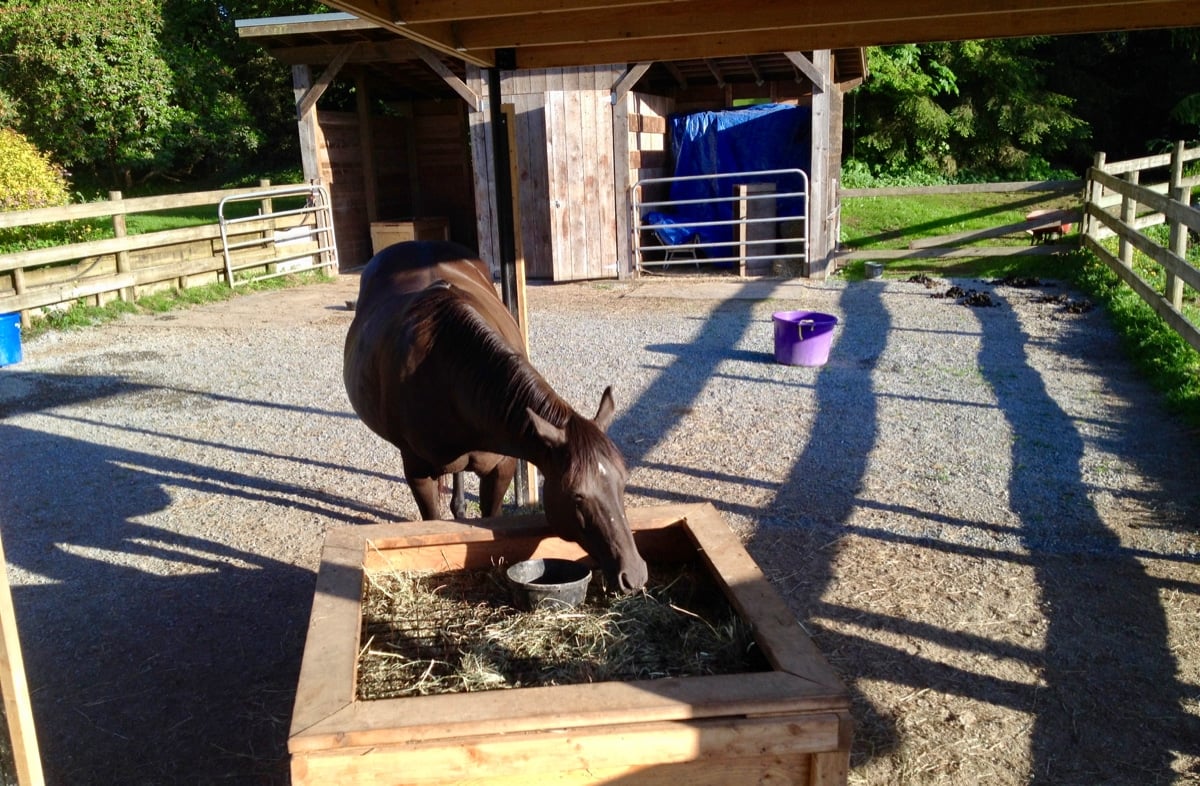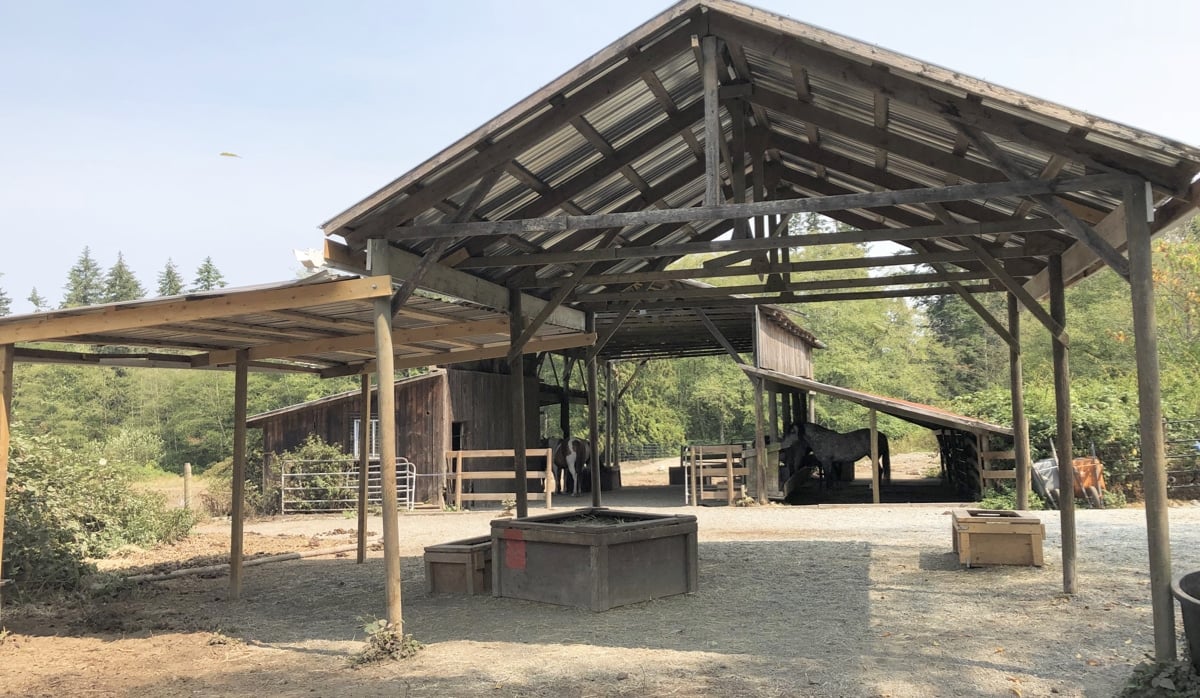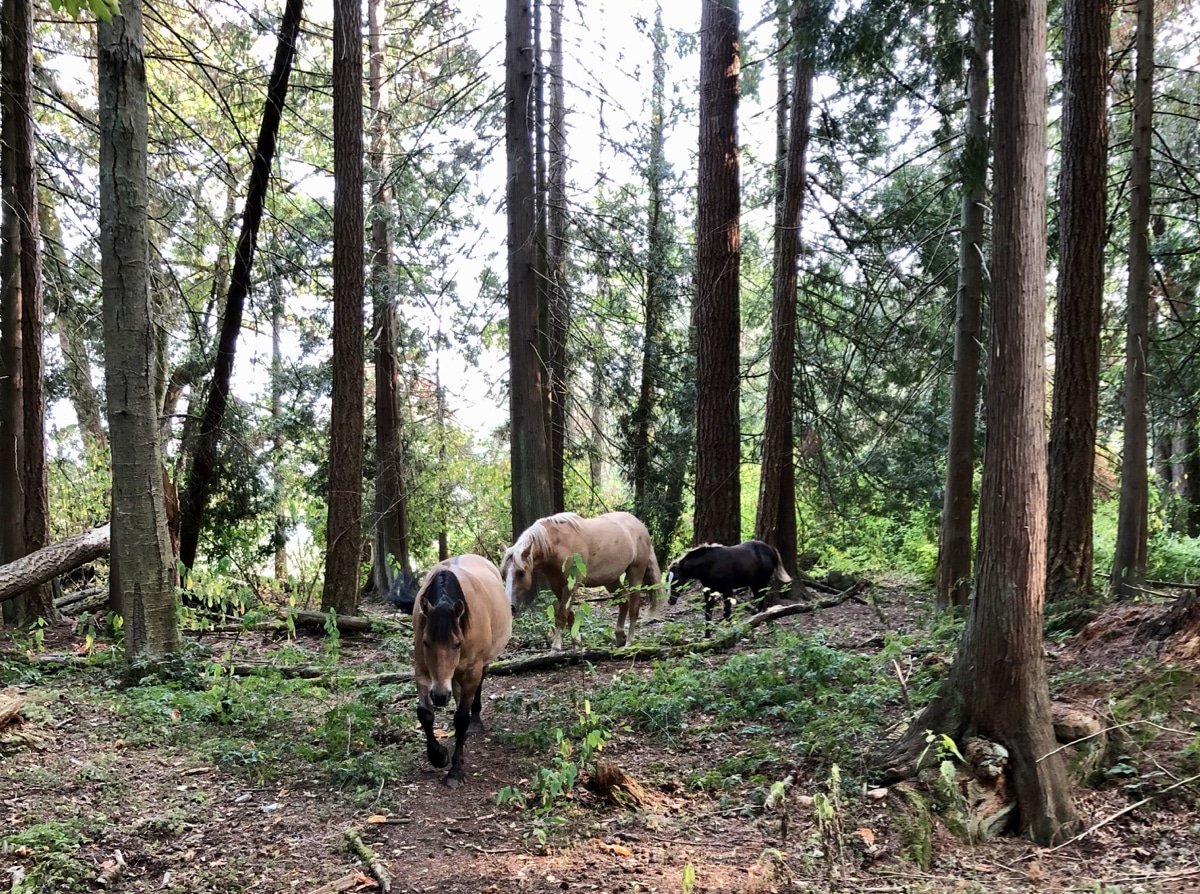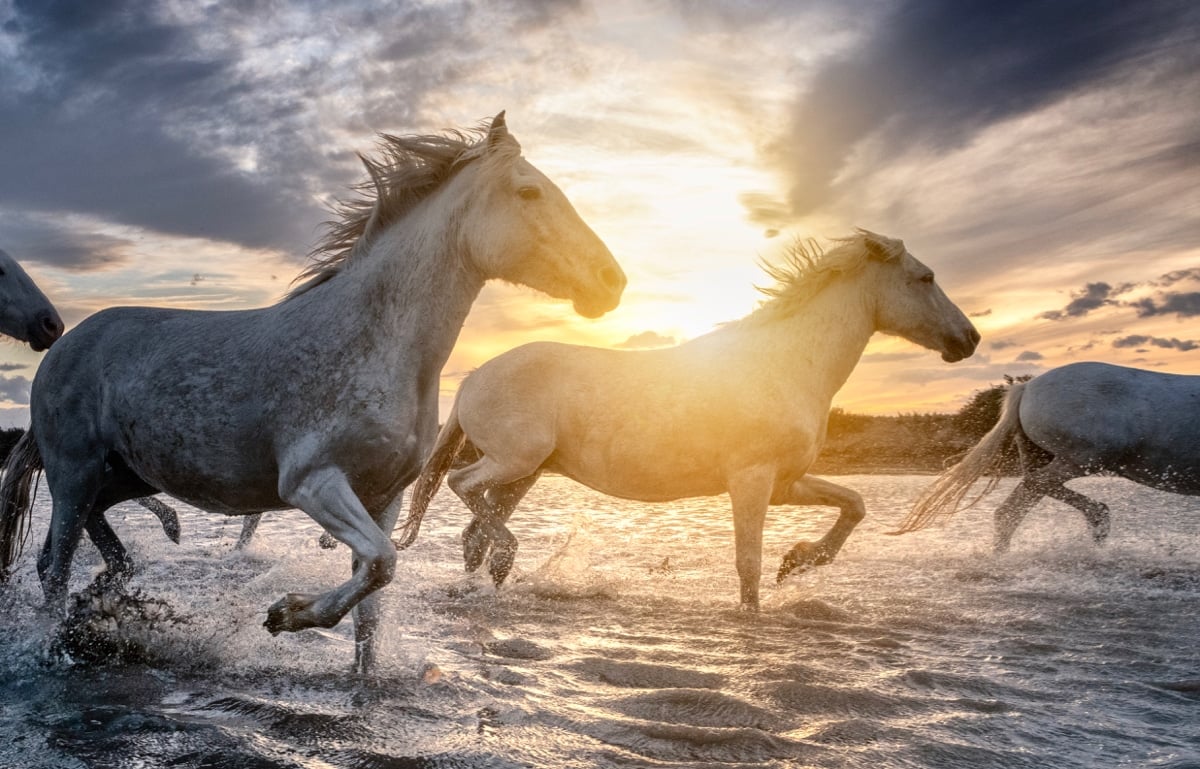Have you ever wondered if your horse needs a winter blanket, a waterproof blanket, a fly sheet, or a fly mask? How do you determine what your horse wants versus your own idea, or fear?
And if you’re in an intimate relationship, where you listen to your horse, and your horse is allowed to own her own body, then how do you determine what your horse’s body wisdom is asking for, or refusing?
I recently received this great question from a reader:
“I’ve just discovered your website – what great info! I live in a climate similar to yours, and I have a small herd of three – a 6 year old OTTB mare, a 21 year old standardbred gelding and a quarterhorse mare (rescue so unsure of her age – maybe 15?).
I was just wondering if you blanket your horses in the rainy season? All the horses have access to their own shelters plus lots of trees to stand under, but often I find them just standing miserably in the rain and I worry about rain-rot/chills, especially with the OTTB as she is more “delicate” than the other two. I’d appreciate your thoughts on this.”
As you may have noticed from my videos, I do not blanket my horses. But they have plenty of shelter and they have slowfeeders under shelter – so they can eat under cover whenever they want.
Interestingly, they do choose to go out in the rain when it is a light or even moderate rain. And I often arrive to see that several, or most of them, are wet. I never disturb their coats by brushing or touching them though, as their winter coats are naturally waterproof. I save my scratches for their belly, which is dry and their favorite spot anyway.
The only time I ever saw a horse in distress from being wet and cold was when Kesia and I first had our horses together (I just had Zorra at the time) and Amalia and Spero locked Zorra out of both shelters – and neither would share with her. The slowfeeder boxes were under shelter and there appeared to be plenty of room for all of them. But Zorra was soaked through and couldn’t get to any food – she was shaking so badly she was almost convulsing from the cold. I was horrified.

I’d owned horses for almost a decade in Alberta with some weeks at -40 degrees Celcius – horses backs, feet, even eyelashes covered in ice, and I had never seen a horse that cold before! That’s when I learned that if horses cannot get under shelter, and cannot eat, then they have no way to warm up or dry off once they get wet and cold. In a heavy rain, or under rain for an extended period, the water can penetrate their coats to their skin. And then they lose the ability to keep themselves warm.
Why horses avoid shelter
The thing you need to watch for is whether ALL your equines have free, non-stressful, access to the shelter(s). The only way to know this is to spend a couple of hours just observing from a neutral spot. Either outside the fence, or in a spot that doesn’t encourage them to interact with you. You basically want them to forget you’re there and just go about their normal business. You’re basically watching to see if you have a dominant horse (or 2) that is preventing others from peacefully accessing the shelters. If a dominant horse is making it too stressful, then that alone will keep the others away.
In this picture you can see how there is another 12×16-foot shelter behind the pole barn shelter. But although this looks like plenty of room to a human, to a fearful horse this paddock is way too narrow to safely pass by the other horses. In addition, a lower-ranking horse is not going to risk getting trapped in the barn shelter by a dominant horse – because there’s only 1 entrance/exit.

Amalia and Spero had been schedule-fed a rationed amount of hay at their last boarding situation. So when they arrived here, they had severe anxiety over food; protecting it from others, fear that there wouldn’t be enough, and memories of acid eating away at their stomach with no food to absorb it. Remember, a horse’s stomach produces acid 24 hours/day, that’s why they are healthiest (physically and psychologically) with 24/7 access to low-sugar hay or forage.
We did some acupressure tapping sessions with Amalia and Spero, made sure everyone had their own feeder, took them out for walks together and other activities to help them feel bonded and safe with each other. Within a couple of weeks the three horses were comfortable with each other and there was no more risk of Zorra getting barred from food or shelter.
Here’s how many horses can easily fit under that same pole barn shelter when everyone feels safe with each other. But note how I have two feeders under here – although each of these feeders is supposedly big enough for 3-4 horses. But from watching their herd dynamic, I quickly realized that these 4 horses could not easily share one feeder:

If horses have free access to shelter and plenty of hay/forage – and in a non-stop rainy climate like ours, the hay/forage needs to be available under shelter – then they are perfectly capable of judging how wet they want to be, or not.
The other aspect I notice from the reader’s email is: “All the horses have access to their own shelters plus lots of trees to stand under…” Does this mean each horse has their own shelter and perhaps is in a separate paddock from the others? Or are they all together in one field/paddock?
Because here’s another consideration: Never underestimate the importance of the herd. We really have no concept of what this is like, or what it feels like, because humans have nothing similar in our existence. We can’t even understand this from our own family experiences (in the West) – just look how many of us take a newborn baby, that was inside our body a few hours ago, and put it alone in a crib, often in a separate room, to sleep. This is how alienated we are from an interconnected existence, like a herd.
I drive by a dressage stable every day near my house. The ‘lucky’ horses are outside where each has a 14×30-foot paddock with its own shelter. Let me tell you, in everything but a torrential downpour, none of these horses are under their shelters! They are all standing outside with rain blankets on, immobile with heads lowered and dripping. Why? I believe it’s because they cannot see each other. The way the shelters have been built and placed, if a horse goes into his shelter, he is immediately cut off from most of the other horses – he can’t see them. So not only is he isolated from that herd/group matrix, he is viscerally in a very vulnerable position: alone in a ‘cave’ where a bobcat, wolf or coyotes could easily kill him.
So being that the herd/connection takes precedence over many things, look to see if your horses are standing out in the rain so that they can be closer to each other? Is that the best way they can maintain their herd grouping or connection? Can they see each other if they are in their shelters?
If the only way they can access their herd connection is to stand in the rain, then it would be ideal to open up the fences and let them physically be together, with the option of a shelter big enough for all of them. And again, observe their natural herd movement to ensure that your idea of a shelter that’s big enough, matches up with their idea or need.

Another option might be to remove a wall or two from your shelter, or open up the top half of the wall, so that the horses can be under shelter yet still see each other. This might not work though, if your horses are still going to feel ‘trapped’ and vulnerable to attack in their shelter. Remember, we’re talking about cellular memory and genetics here – not whether it’s reasonable or realistic for your horse to feel unsafe.
If none of those options are possible, then you may want to offer them a rain sheet.
Allowing your horse to tell you if they want a blanket
When Zorra first moved to BC from New Jersey, she got eaten alive by the bugs here and the bites swelled up into welts all over her body. She gladly accepted a fly sheet. But after a few weeks and her body had adjusted to the new bugs, she didn’t want a fly sheet anymore. Neither did she want a fly mask.
An easy way to determine whether your horse wants a blanket, sheet, or mask is to put it on them once – so they understand what it is, and the benefits it can bring. They will also experience what it feels like to wear the blanket or mask.
Thereafter, simply hold the blanket or fly mask out and offer it to them (unhaltered). If they hastily move away – that’s a hard No. If they sniff it and turn away, then you can move to put it on, but stay in listening as they may not have understood that you wanted to put it on! They may just have thought you were showing it to them. Again, if they then definitively move away or otherwise avoid cooperating, that means No too. If you want to get complicated about it, then researchers found you can train them to touch different signs/symbols to communicate what they would like.
For the first few weeks, I would remove Zorra’s fly sheet while I was there. It was important to give her body and immune system some exposure to the new environment, so her body could learn how to deal with it – without being overwhelmed and going into a flare or allergic reaction. I also discovered that spraying natural bug spray on the fly sheet worked much better than spraying it on her body. I was also able to use a much stronger concentration of essential oils because it was not going directly on her skin.
So I would spray the fly sheet with an essential oil and glycerin-based (glycerin is sticky so helps the solution adhere to the surface) bug spray while it hung over the fence. Then I would walk over to Zorra and put it on. Sometimes she would even walk to meet me – a clear indication of, “Yes, please put it on!”
When she no longer wanted it, she moved a few steps away from me as I attempted to place it over her. Just to be sure, I tried again. And again, she sidled away from me. Okay, that’s a pretty clear message, “No thanks”. I offered it every day after that for a few days, but she kept refusing, so I trusted her body wisdom and got the message that she didn’t need it anymore.
I used a similar process to administer a chemical wormer to my semi-feral horses when they were unhaltered and at liberty in a 5-acre field. Even with something as noxious as a drug worming medication, the horses knew when their body needed it.
I often see horses in a field where the weather started out nasty in the morning, but by afternoon there is beautiful sunshine. I feel so sorry for those horses sweltering under their waterproof blankets! I’m sure that horses can read the weather much better than we can. If you’re an owner who has to go to work for the day and thus needs to make a decision in the morning about whether to blanket or not, imagine if you could ask your horse what they want!
Of course, even better is to set up your horsekeeping facility so that your horse has 24/7 access to shelter and low-sugar hay in slowfeeders so they can always make the best choice for their body’s needs. Rather than being driven by hunger or lack of options.
Do trees provide enough shelter?
I am a huge fan of having treed areas for horses to enjoy, forage and run through. I had no idea how much horses love the forest (and how much the forest loves the horses!) until I moved them onto this property. If you haven’t seen any of my videos of them in the forest, this one is a great place to start.
However, the other thing I didn’t realize is how often trees and branches fall in a forest! So whenever there is any wind heavier than a light breeze, my horses will not go into the woods. They know not to stand under trees that may be dropping a sharp, heavy branch on top of them, at any time.
In fact, horses know all kinds of things about trees that we don’t… One day the entire herd – except for my domestic-born horse Zorra – refused to follow me into the woods at dusk, even though I had a whole bag of apples. My idea was that I would hide the apples in the forest and they would search for them, and wouldn’t that be a wonderful game! There was some part of my brain clocking the fact that all my wildies were lined up 5-6 feet away from the edge of the forest, looking at me intently, but not budging an inch. But the rest of me barged on ahead, thinking that I just had to show them what a great idea this was and once they understood what I was doing, they’d be all in.
About two minutes later I stepped on a wasp’s nest. Did you know that wasps build nests underneath fallen logs? And that dusk is a very active time for wasps? The wildies knew. I completely destroyed the wasp’s home, and rightly so, they retaliated with a vengeance. I streaked toward the large water trough and jumped in. Game over. I have watched and listened closely to the wildies ever since. They live outside 24/7. They also live inside their own bodies 24/7. How could my knowledge of their body’s needs and desires possibly surpass theirs?
Our idea of using trees for shelter may not concur with their idea. It depends on the trees, and their placement, and the wind, and the health or lifecycle of the tree, etc. Our horses are a much better judge of whether and when it’s safe to stand under a tree, than we are.

So again, watch and observe your horses. Maybe they will stand under the trees when they want to meditate on a hot day, but they won’t stand under them when it’s raining. If so, I guarantee you they have a good reason. One thing I can say from my own experience of standing underneath trees during rain, is that some species of tree are good shelter from the rain, and others actually funnel more water onto you!
The ground can actually be wetter under trees, than on a higher bit of ground with no cover. Maybe your horse hates cold mud-encased feet more than he hates a wet coat?
Many children refuse to wear socks and parents assume it’s because they don’t like having their feet enclosed in socks. But guess what? Turn the socks inside-out and all of sudden most children will wear them. Why? Because it is the seam across the toes that is uncomfortable for the child, not the socks themselves.
As a care-giver in a domestic situation – whether caring for animals or children or elderly – we can get so caught up in the responsibility of our role that we forget to keep the sentience and the body wisdom of the loved one paramount. We forget to truly listen, to spend time simply observing. Nature will always give us the answer if we can bring ourselves back to that place, to sit quietly in the inquiry of observing, “What wants to happen?”
If we can re-orient ourselves to align with the sentience of nature and all living beings, instead of trying to force them into our preconceived ideas (for their own good of course!) then all of our lives will get a whole lot easier and less stressful. We will create more space for love and connection. We will create intimacy and trust with our equines. And then the serious magic can begin.

Jini Patel Thompson is a natural health writer and Lazer Tapping instructor. She began riding at age 2 in Kenya, and got her first horse at age 8 in Alberta, and so continues a life-long journey and love affair with these amazing creatures.











Wht a brilliant article. Thank you so much.
You’re welcome 🙂
Hi Jini,
Thanks for this! I’ve heard that certain trees (Oak, Red Maple, Walnut) can be toxic to horses. Would you allow your horses to roam free in any forest if it had such trees?
Joan
Hi Joan …just want to let you know…the herd …4 horses…I share life with live with many varieties of Oaks…and in the fall …eat acorns by the hundreds…so far so good…and we have been here now 5 1/2 years! ✌🏼❤️🐴
Thanks to Michelle for the reply about Oak trees. I have LOTS of toxic plants, berries, etc in my 30 acre field and forest. The horses have never ingested anything that caused a negative effect. They also seem to know when they can ingest plants – for example, that are toxic in summer, but not in the young growth of spring. And they also know which part of the plant they can eat. With certain ferns, for example, they will only eat the tips.
However, I think they are empowered to be choosy and discerning because they are given free-choice hay (low sugar) in slowfeeders 24/7. So they are not forced to eat out of hunger or stomach acid production. We have to consider the whole horse in these matters 🙂
Hi Jini,
Wonderful info! Thank you so much. Now that I’ve messed up and have been blanketing my horses all winter so they haven’t grown a proper winter coat, what do I do? Can I ask what the dimensions of your pole shelter are in the first photo?
Really appreciate your advice!!
Shelly
Hi Shelly, that pole shelter is 12×24′ – but if I built it again, I would make it 16×24′ which gives lots more options for feeder placement and configuration.
For blanketing, how about giving them a choice on milder days? As Kesia pointed out in her comment, it might take a while for them to realize they now have a choice and you may need to give them a margin of error without having to suffer too much! Let us know how it goes… 🙂
I love everything you say in this article! Let’s observe more, listen more, to allow what wants to happen, to happen.
Amen Denise!
Howdy all!
I have had a few experiences listening to horses with blankets and fly masks! I came to horses kind of late in life …around 40! An amazing human knower horse “who would be called Big Acea “ and his companion Red rescued me. Big Acea was very sick and very starved! They both went directly to a ranch and into stalls from the 2 acre neglected environment they had come from! My friend who had horses all her life was part of the rehab! She insisted on blanketing him …as he was so thin and sick! Once they both got healthier and stronger I insisted they have more space as I hate cages! They went out into about an acre! Then because of my passion for the horses I let my house get foreclosed on (upside down on it) and my mom and dad helped us buy an acre property so I could live with the horses! I know not ideal but thats how strong my desire was! Anyway one very cold rainy night my GF and I were partying and she said you need to go put a blanket on them? I said ok! We went out to try and Big Acea tried to bite me over and over! He was clearly telling me I don’t need that anymore…but we insisted! I tried a few more times after that and he continued to try and bite me…that was one of the many times he helped me listen to him! He was an absolute genius at making me hear him and showing me what was right for him! So I do not blanket! But along came Buck a couple a years ago….my neighbors bought him then gave him to me! I think he was a stall/blanket/fly sheet kind of kept horse! So Same as Zorra ..he reacted very badly to the bugs and I also saw him shiver once in the winter in a bad storm! I figured he would grow a better coat this year and acclimate to the bugs! Well he acclimated to the bugs beautifully with the additional support of herbs and diet! But a couple of weeks ago when it actually got cold again here in our part of California …he got wet and was shivering again! So this shows me I need to add some more shelters and incorporate permanent slow feeders! The horses I share life with live with me on 12 acres…and I work at home so handle hay spreading many times a day …to facilitate movement! So I haven’t done permanent slow feeders yet!
I think a couple of things Jini didn’t mention is movement! When Buck is cold he will really get the other three moving! So grateful he has the space to do so! This is also one reason I do not want to blanket him…it seems a blanket could become very dangerous in high energy situations? Also sand can be a great benefit for helping them dry off! It’s a double edge sword though as it can be dangerous …to have it around food …but if you have a separate space for it to stay dry …the horses always roll over and over again in it to dry themselves! Jini made so many good points about so many things and especially trees! They do drop a lot of stuff in the wind and rain! It’s one bad flaw in the shelter we built it’s shaded by a large oak! So the horses don’t like the loud sound of stuff falling on it (tin roof) in the wind and rain …but it’s there got to in the summer and they love it….but for winter ….we need another or couple other alternatives! Because again like Zorra …Bullet gets bullied by Buck and he won’t let him near the shelter! Dreamer and Banner try and help but sometimes Bullet just gets screwed!
Regarding fly masks we get May flies …which sworn on the face in the hundreds….and for about a month or two our horses beg for there masks but then …after that…say No.. no need for just a handful of flies! I also remove them each night so they don’t have to wear them 24/7! I see a lot of neighbors that leave them on for months…this can not be comfortable or ideal? In fact the neighbor who I have become very close with use to do the same and putting it on her horse was a 1/2 hour project…but now that they remove it each night he gladly excepts it….he has pink eyelids so really needs it for sun protection too!
I agree it’s not always easy or economical to create what best for the horses we care for but we must keep striving to listen and try! ✌🏼❤️🐴
GREAT info Michelle – thank you!
Regarding the tin shelter roof – I put a layer of plywood under the tin to mask sound. I was in a downpour under a tin roof once and couldn’t believe how LOUD it was – so I specified that and am pleased to say it helps a LOT.
I love the sand idea – if your climate isn’t continually wet that could work well. Here the sand would just get wet from them tracking in and out and lying down on it etc. Even drainage gravel gets soaked in this climate 😉
And movement – yes. But again, in a climate that rains non-stop day and night for 5 weeks… even the horses get depressed and don’t want to move too much. Unless you’ve got Jax, Juno and Montaro around to get everyone running, they prefer to be sedentary and spend a lot of time under shelter with the slowfeeders. In a more varied climate, or one where you get snow, movement can easily enable them to warm up.
I love your fly mask story – illustrates PERFECTLY the power of choice and how it benefits everyone! xox
My three horses that wore blankets regularly when they were in the same climate flat out refuse them up here. But here’s the thing – even in the pouring rain. We do get torrential rain at times, but never for days and days like on the coast. The first time I saw my horses shiver (yes, the same two who banished Zorra from the shelter), was at another boarding facility, where they were not able to access shelter and eat and the same time – that’s when I went out and blew my paycheque on two horse blankets (they are almost exclusively used as wind-breaks on pig shelters now…hmmm). Horse’s coats are capable of shedding quite a bit of water, but even when soaked my herd are warm to the touch. We have a bit of shelter here, but because we don’t feed under it, they only spend the worst weather hunkered under it, and only for a short time – but I think because they have continual access to food, and are nearly always moving, they are able to generate enough heat. In driving, windy rain they stand in the open with their butts to the wind, which shelters their heads.
In the extreme cold, they still refuse blankets. Admittedly, some of them have never worn them, but those that have pin their ears and swing away when they are offered. The horse’s coat is so developed to react to weather and temperature, that they need full control over it to keep themselves warm or cool. They are continually puffing or smoothing their hairs to create the right climate close to their skin. When I’ve been anxiously asking Amalia (who is 21 years old and very sensitive) to wear a blanket in the cold, she has reminded me that it will limit her ability to loft her coat and create more insulation between the hairs. And if I do that, and she gets chilled, I don’t have backup – like a heated barn – to fix my mistake. So we both feel safer letting her move and eat her way through the hard weather.
This winter was the first time I’ve seen anyone shiver, and while it was absurdly cold, the real issue was that I had gotten a new delivery of hay, and it wasn’t as yummy as the last hay. The timing couldn’t have been worse, but of course the whole herd went on hunger strike, spending most of their time nibbling the remnants of the old bale and ignoring the new bale. As soon as I realized what was going on, I laced the new hay with sunflower seeds, lured everyone out, and sort of “bonded” them to the new pile of hay – problem solved, and no more shivering once they were eating enough again.
I don’t have a high opinion of blankets in general, but I do understand they can be important in particular scenarios, and that is up to the horse and the human, as well as the context – weather, health, environment, food. I would add one caveat to asking the horse – horses that have been conditioned to accept a blanket may not understand that they are being offered a choice, and so you might not get a definitive “no” until they are more empowered to decide for themselves.
There was a study I read about where horses were able to not just accept but ask for a blanket if they wanted one, or indicate that they wanted their blanket off – or none at all. It helps to know that horses rarely *need* (or, as I’ve noted in my herd, want) blankets if given enough room and food to generate their own heat. Horses can warm themselves up a lot more easily than they can cool down, which is important to remember when blanketing – how much is too much?
Great info here Kesia – thanks!!
And yes, very true about horses who are conditioned taking a while to realize they have choice. Here’s that study you referred to – I will add a link in the post too:
https://thehorse.com/149916/study-horses-can-communicate-blanketing-preferences/
I love Amalia’s point about being able to loft her hairs – just brilliant!!